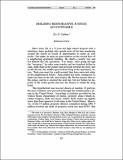| dc.description.abstract |
Part I of this Article provides a better understanding of therestorative justice theory and its practical expressions. It describesthe values and objectives upon which restorative justice is premisedand introduces the three most common restorative justice practices:victim-offender mediation, group conferencing and circles.Part II introduces the democratic experimentalism model and demonstratesits compatibility with the restorative justice theory. PartIII introduces four restorative justice programs currently operatingin the United States, two operated by courts and two by prosecutingagencies. Part IV demonstrates the inadequacy of the evaluationmechanisms currently employed by these programs andemphasizes the importance of comparison between different programsin holding restorative justice programs accountable. Part Vestablishes the compatibility of all four case studies with a democraticexperimentalist regime and demonstrates the practicality ofthis proposal. Finally, part VI illuminates and discusses the difficultyof comparing very different restorative justice programs, butconcludes that such a comparison, as an inseparable component ofan experimentalist regime, is essential for effective programaccountability. |

